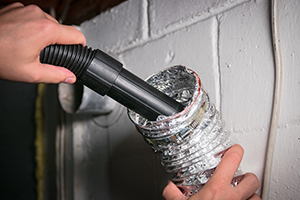 Even if you faithfully clean the lint filter after every load, it’s the lint you can’t see that poses the biggest fire risk. The National Fire Protection Agency reports clothes dryers are to blame for 92% of all laundry room fires, and on average they cause $200 million in property damage each year. The culprit—failure to clean lint buildup in the dryer vent and duct. Lint is highly flammable and can get stuck in the nooks and crannies of the vent duct, the tubing that vents your dryer to an outside exterior wall. Dryers must have proper airflow to prevent heat from building up in the duct. When a blockage restricts that airflow, it can spark a fire and quickly ignite any lint that has built up inside.
Even if you faithfully clean the lint filter after every load, it’s the lint you can’t see that poses the biggest fire risk. The National Fire Protection Agency reports clothes dryers are to blame for 92% of all laundry room fires, and on average they cause $200 million in property damage each year. The culprit—failure to clean lint buildup in the dryer vent and duct. Lint is highly flammable and can get stuck in the nooks and crannies of the vent duct, the tubing that vents your dryer to an outside exterior wall. Dryers must have proper airflow to prevent heat from building up in the duct. When a blockage restricts that airflow, it can spark a fire and quickly ignite any lint that has built up inside.
This fire hazard is preventable though, with routine inspections and a little maintenance.
Warning Signs
You may find that your clothes take longer to dry, you may notice a burning odor or your dryer may become hotter than usual to the touch. All of these are signs that you should immediately stop the dryer and look for the problem. Lint may be clogging the duct and vent, or there may be other problems.
Clogged Dryer Vents, Ducts and Filters
Cleaning the filter after each load of laundry is a great start, but you should also check the duct and vent that connect the dryer to the outside of your home. As lint makes its way through the duct, it may get stuck on an outside vent hood. If your dryer vent is protected by an exterior flap, to keep birds or rodents out, check the flap periodically to make sure it’s working properly. It should open when the dryer is in use and close when it’s not in use.
The location of your dryer inside your home could also pose a problem. Today, more laundry rooms are located upstairs or in other areas of a home where a longer dryer vent duct is needed to reach an exterior wall. This can create a dangerous situation, especially if the duct bends and turns. As moisture in the warm air passes through the long vent duct, it can condense, attracting lint and causing it to accumulate, which can eventually cause a clog. The duct should be routinely checked for clogs and cleaned to prevent lint buildup.
You also want to check behind the dryer itself and inspect where the duct vent connects to the exhaust on the back of the clothes dryer. Unplug the dryer and carefully disconnect the duct from the dryer to clean out any lint that has accumulated inside the dryer’s exhaust. Also check for lint trapped in the ridges of flexible, foil duct lines. If it is punctured or damaged, it’s time to replace the duct attached to the dryer.
Clean Twice a Year and Have a Plan
It’s recommended that you clean your dryer ducts twice a year, if possible, and at a minimum, they should be cleaned at least once a year. It can be an easy do-it-yourself project with a little time and research. If you have a long dryer vent duct with twists and turns before it reaches an exterior wall, you may want to call in a pro.
For added peace of mind, consider putting a heat detector in the laundry room to alert you if a fire ignites. Keep the dryer clear of combustibles, and never operate your dryer when you’re not home or while you sleep. In case of a fire, have a safe exit plan, practice it with your family, and never put your safety at risk trying to extinguish a fire.